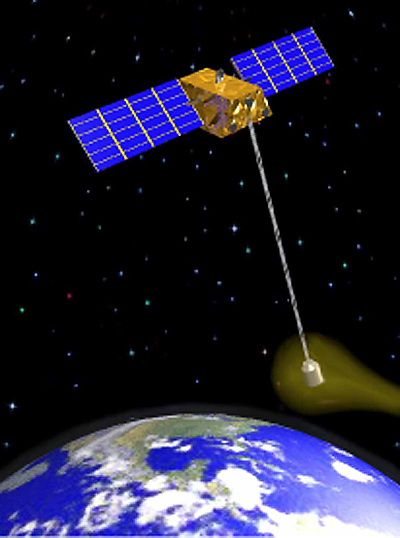The Terminator Tether Aims to Clean Up Low Earth Orbit

Fortunately, the old orbital forts were superbly equipped for this task...(Read more about Operation Cleanup)
It has been suggested that every satellite deployed should carry extra propellant so the satellite can boost itself up to a higher "graveyard" orbit. Unfortunately, not only must the extra kilograms of propellant be boosted up from Earth, the rocket and guidance systems must be usable for many years after launch. Also, graveyard orbits merely leave satellites up higher, where micrometeorite damage slowly causes these objects to break apart; smaller fragments will filter back down, leaving this problem for our children to solve. These smaller fragments are almost impossible to clean up.

Extra propellant could also bring the satellite down; of course, this also requires that the rocket and guidance systems work at the end of the satellite's life. If either system fails to work, the satellite stays right where it is.
It would be more practical (as well as more responsible) to solve this problem at the start.
The Terminator Tether (TM) from TUI may be able solve this problem. Currently under development, the Terminator Tether will provide a low-cost, lightweight and reliable method of removing objects from LEO. It consists of a lightweight electrodynamic tether 5 kilometers in length wound onto a spool.
Here's how it works:
The Terminator Tether is bolted onto the satellite during construction. Once launched and operational, the device is dormant, waking up periodically to check the status of the satellite and to listen for activation commands. When the command to deorbit the spacecraft is given, the 5 kilometer cable is deployed. The cable interacts with ionospheric plasma and the Earth's magnetic field; this produces a current along the tether which causes a net drag on the spacecraft, lowering its orbit until it burns up in the Earth's atmosphere. (To find out about the forces that electrodynamic tethers bring to bear on spacecraft, read Electrodynamic Tethers - Bring Down Debris or Boost Spacecraft and Non-conductive Tethers - Artificial Gravity in Orbit.)

| Constellation | Altitude | Inclination(Degrees) | Deorbit(Natural) | Deorbit Time(with TerminatorTether) |
| Orbcomm1 | 775 km | 45 | 100 years | 11 days |
| LEO One USA | 950 km | 50 | 100 years | 18 days |
| GlobalStar | 1390 km | 52 | 9,000 years | 37 days |
Get the Space.com Newsletter
Breaking space news, the latest updates on rocket launches, skywatching events and more!
Join our Space Forums to keep talking space on the latest missions, night sky and more! And if you have a news tip, correction or comment, let us know at: community@space.com.
Bill Christensen is the founder and editor of Technovelgy, a website dedicated to cataloguing the inventions, technology and ideas of science fiction writers. Bill is a dedicated reader of science fiction with a passion about science and the history of ideas. For 10 years, he worked as writer creating technical documentation for large companies such as Ford, Unisys and Northern Telecom and currently works to found and maintain large websites. You can see Bill's latest project on Twitter.









